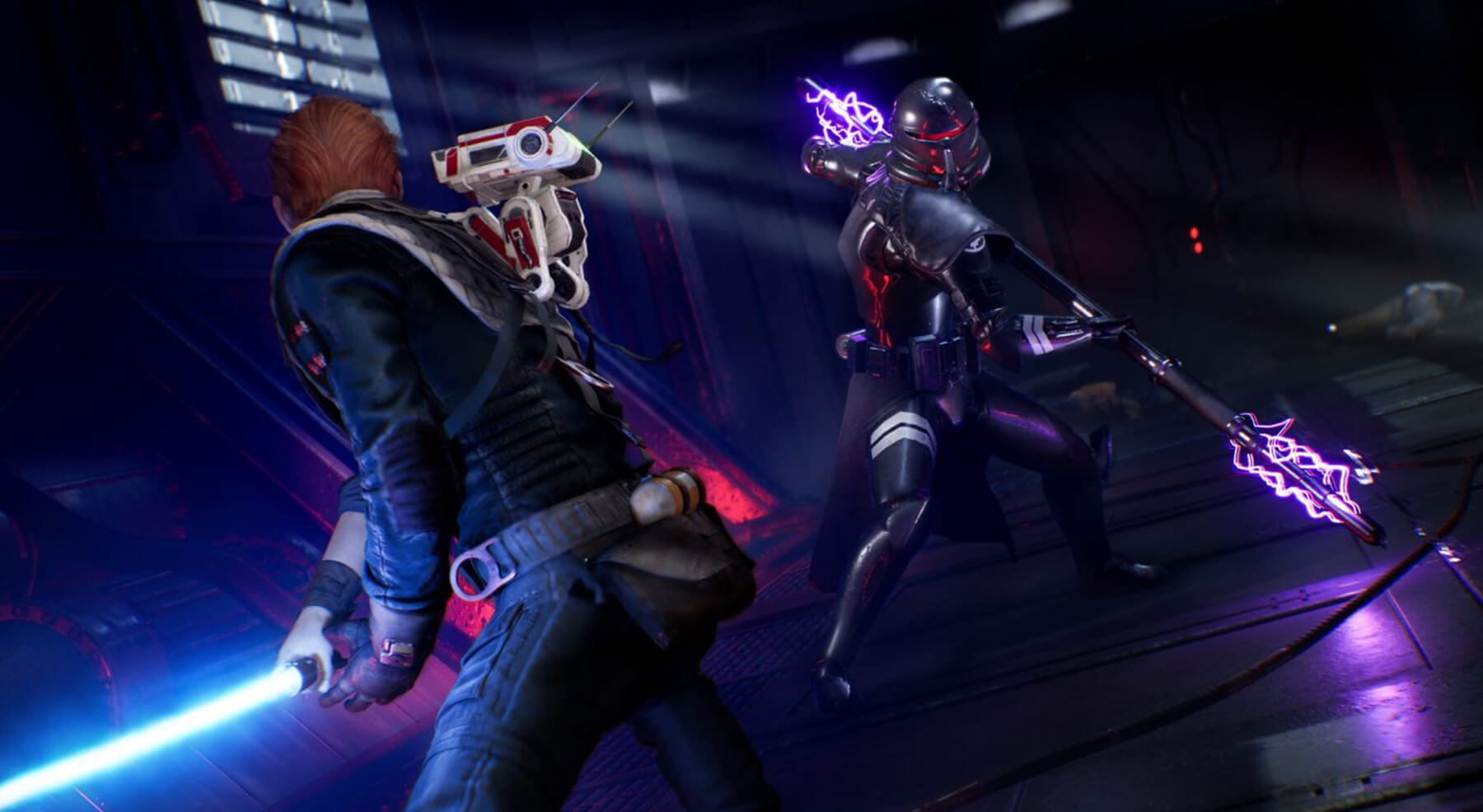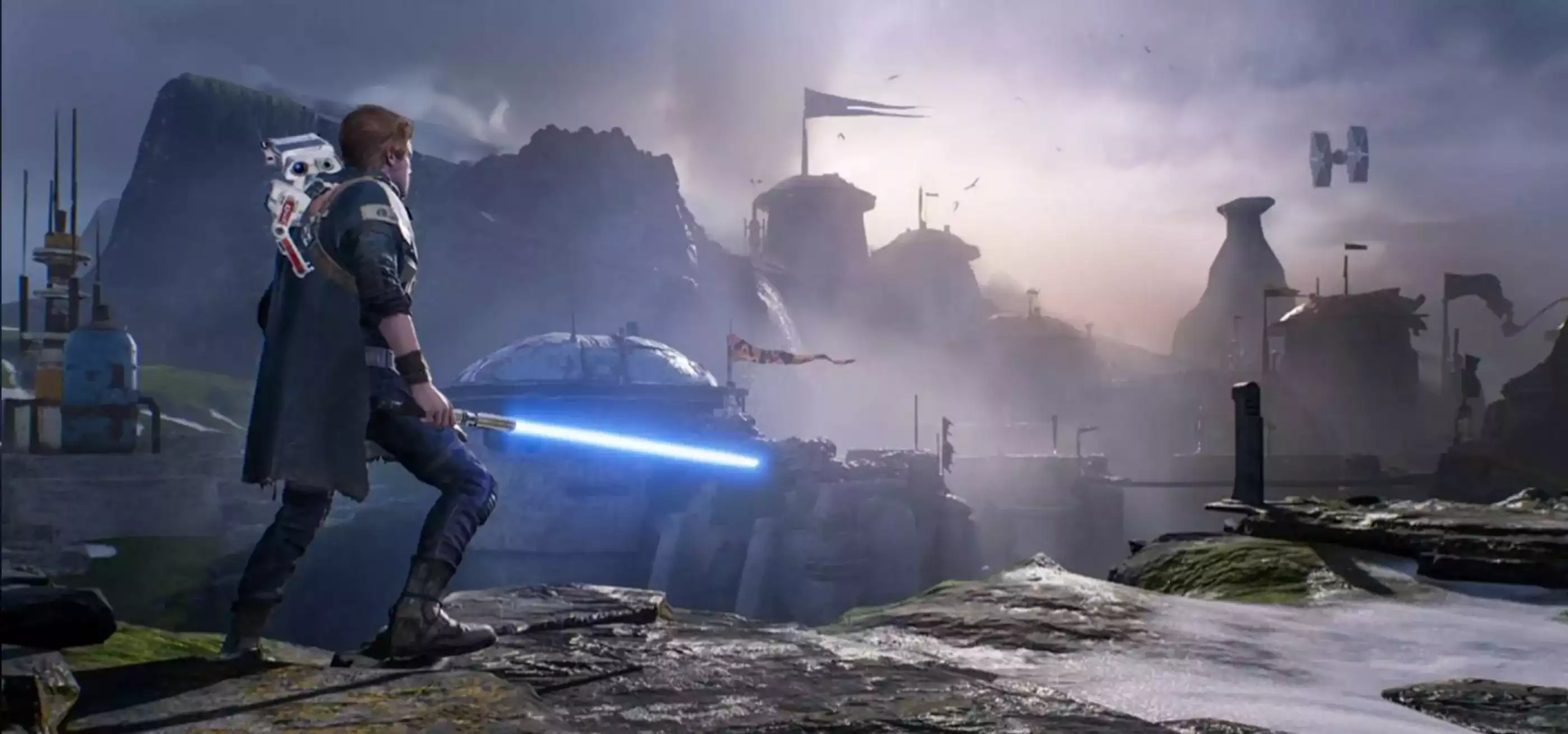In the Star Wars films, Jedi fight scenes are like elegantly choreographed dances — full of deft footwork, elegant swordplay, and gravity-defying leaps. Respawn Entertainment’s STAR WARS Jedi: Fallen OrderTM, the latest video game set in the Star Wars universe, gives players a taste of the action as they take control of Cal Kestis, a Jedi Padawan on the run from the Galactic Empire.
“The game’s tagline is ‘Become a Jedi,’ and we really took that to heart during development,” says 2016 BS in Computer Science in Real-Time Interactive Simulation graduate and Respawn software engineer Joe Lubertazzi. “We wanted the player to feel agile and graceful as they navigate the galaxy.”
Making players feel like a Jedi is no easy feat, but according to Lubertazzi and the other DigiPen alumni who worked on Fallen Order, the Respawn team trusted the Force would help them navigate this challenge. “One of Respawn’s mottos is to make games that feel good,” says 2016 BA in Game Design graduate and Respawn combat designer Jason Zhu.
But how do you make players feel as good as Jedi look in the movies?
One crucial component was nailing the game’s lightsaber combat. “Making sure the lightsaber felt deadly was a huge challenge,” Lubertazzi says. “How do you present challenging and engaging gameplay when your lightsaber is supposed to slice through everything with ease?” Zhu and the combat design team tried to find a balance through a clever compromise.
“We pushed for as few body hits as possible against humanoids to sell the lightsaber’s power once it makes contact with an enemy body,” Zhu explains. “To allow for that without making fights really short, our melee trooper variants have weapons that can block lightsabers.” Implementing a parry and posture-based combat system, the game rewards the same precise timing required of Jedi in the films by forcing players to break an enemy’s guard before they can land a finishing blow. Out of that combat compromise came one of Zhu’s proudest achievements in the game — developing the AI for the imposing electrostaff purge trooper enemy, a type of soldier specifically trained to parry and kill lightsaber-wielding Jedi with a double-sided electrostaff.

Lubertazzi, whose main focus on the game was physics, collision, and character motion, took lots of cues from the look and feel of the films when considering his particular responsibilities. “Personally, working with such a storied IP as Star Wars brings a real gravity to just how many people will intimately care about the small details,” Lubertazzi says. “Everything Cal Kestis does — how he runs and jumps, the flourishes of his lightsaber as he swings it around, how he recovers after taking a blow, how he deflects blaster bolts back at stormtroopers, the sound of his lightsaber igniting, the way he dresses — we tried to give it all an authentic Jedi feel.”
Working within the Star Wars galaxy was also a high point for 2018 BA in Game Design graduate and Respawn level designer Nick Cameron. Cameron was the primary level designer for Ilum, the icy planet where Jedi-in-training go to find crystals for their lightsabers as a rite of passage. “I found working within the Star Wars galaxy to be really exciting, especially as the main planet I worked on, Ilum, is a planet that already existed prior to our game and has other stories around it in the Star Wars galaxy. Not only is it an important place for Jedi, it has a number of established locations which we wanted to work with,” Cameron said. His proudest achievement, he says, was designing a puzzle that relied solely on elements derived from previous depictions of the planet. “The constraint of staying true to all of that was difficult, but I think it paid off since fans will be able to walk through and recognize different parts of it. It also means I got to directly impact the details of an iconic location, which is pretty rad,” Cameron said.
Although STAR WARS Jedi: Fallen OrderTM was developed in deep collaboration with Lucasfilm to ensure its lore was accurate, the developers note that it also breaks new ground in important ways. From a video game perspective, it’s one of the first Star Wars games to implement “Metroidvania” level design, a non-linear style that requires players to backtrack to previous locations in order to progress and unlock secrets. “To me, working on a game in this style is a level designer’s dream,” Cameron says. “It presents lots of interesting challenges. You get to think about not only the player’s first experience through a level, but also all of the different times they re-traverse with new abilities or after unlocking different shortcuts. It adds a lot of exciting depth to the levels.”
Zhu, Lubertazzi, and Cameron all agree that one of the most crucial elements in crafting such a massive AAA game project was knowing how to work on a team, a team that comprised other fellow DigiPen alumni including Robert West, Garrett Woodford, Adrian Sotelo, and Kurihi Chargualaf. It’s a skill they say they figured out during their DigiPen days.
For Zhu, learning how to communicate his needs as a designer was key. “This was the first project where I’ve had to work with so many different people across so many various disciplines,” Zhu says. “Learning to prototype gave me a method to present my designs in the best way possible, and an understanding of how to implement art and sound assets made it easier for me to communicate with those departments.”
For Lubertazzi, learning how to boost team solidarity was important. “Great games are made by great teams, made up of extremely smart and creative people. DigiPen’s approach to organic team building and game development helped me learn some soft skills that are absolutely necessary day-to-day in the industry,” Lubertazzi says.
For Cameron, it was simply knowing that two heads are better than one. “Collaboration is key,” Cameron says. “When you’re working on something, involve the people you are working with as much as possible. Games are a collaborative medium, and you make great games by having everyone creatively invested and excited!”
